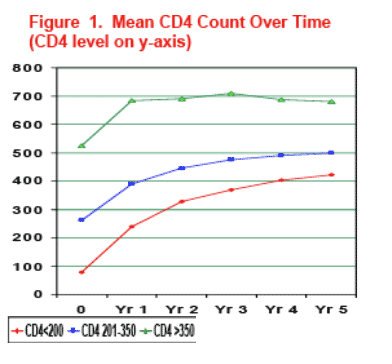 |
 |
 |
| |
Starting HAART Earlier Results in Highest CD4 Count
|
| |
| |
"INCREASES IN CD4 CELL COUNT OUT TO FIVE YEARS IN
PERSONS WITH SUSTAINED VIROLOGIC SUPPRESSION"
Reported by Jules Levin
There were several studies at CROI reporting better outcomes for patients when HAART was initiated earlier, at a higher CD4 count. these studies found higher CD4 counts were achieved, lower rates of AIDS occurred, and in the HOPS study the incidence of certain diseases -- renal, neuropathy, body changes - were lower and lower mortality and incidence of OIs, when HAART was started earlier & if HAART was uninterrupted.
CROI: Early, Uninterrupted ART Is Associated with Improved Outcomes and Fewer Toxicities in the HIV Outpatient Study (HOPS) (02/23/06)
CROI: Early HAART Associated with Improved Outcomes & Fewer Toxicities (02/14/06)
13th CROI
poster 529
Jeanne C. Keruly* and Richard D. Moore
Johns Hopkins University School of Medicine, Baltimore, MD
The main finding of the authors:
At 5 years, patients who initiate HAART with lower CD4 counts never achieve CD4 levels that are comparable to those who initiate treatment at CD4 > 350 cells. Consideration in initiating HAART at CD4 >350 to achieve full immune
recovery is warranted. Patients who initiate HAART at >350 CD4 count in this study achieved the highest CD4 count. Only patients with baseline CD4 >350 returned to near normal CD4 levels. By 5 years, mean CD4 was 423 in those with baseline CD4 <200, 501 for baseline CD4 201-350, and 681 for baseline CD4 > 350 (Figure 1).
Additional conclusions by authors:
Among patients on HAART who achieve durable viral load suppression to <400 copies/mL, an increase in CD4 cell count is achieved and maintained in all CD4 cell strata out to 5 years.
- The largest increase in CD4 cell change is seen in the first year across all CD4 strata.
- Significant increases in CD4 count to five years are only seen among patients starting out at low CD4 cells counts (<200). Leveling off of CD4 gain is seen after the 3rd year among those with a starting CD4 200-350, and year one among patients with starting CD4 >350. This suggests a plateau effect for achieving full immune reconstitution.
- Patients with IDU risk have less of an increase in CD4 cell
In multivariate analysis, the only factor associated with an increase in CD4 count was IDU. On average, by 5 years, patients with IDU risk had 82 cells less. Sex, race and HAART regimen were not associated with the change in CD4 cell count over time.


ABSTRACT
Background: Sustained suppression of HIV-RNA by HAART results in immunologic improvement, even among those with low pre-therapy CD4 levels. However, it is not clear whether the CD4 will improve to normal levels, or whether it reaches a plateau over time. We characterized the increase in CD4 level in patients in clinical practice who maintained sustained virologic suppression for up to 5 years.
Methods: All patients were from the Johns Hopkins HIV Clinical Cohort, a
longitudinal observational study of patients in primary HIV care in Baltimore, MD, who (1) were followed for at least 1 year on a HAART regimen, and (2) had a sustained HIV-RNA suppression to <400 copies/ml for the duration of therapy. We analyzed the annual change in CD4 for up to 5 years from the start of HAART. The analysis was stratified by baseline CD4 as <200, 201-350, >350 cells.uL. We compared the overall and annual incremental change (slope) in CD4.
Results:
261 patients were followed for a mean of 1225 days (range 366- 3300).
Median age = 39 years, with 68% male, 66% black, 30% IDU risk, and mean baseline CD4 of 234 (Q1 57, Q4 372).
The mean change from baseline to last CD4 was +258 cells, with 91% of patients having a CD4 increase.
By 5 years, mean CD4 was 423 in those with baseline CD4 <200, 501 for baseline CD4 201-350, and 681 for baseline CD4 > 350 (Figure 1).
For all CD4 strata, the largest increase in CD4 slope was in year 1. For baseline CD4 <200 (Figure 2), significant increases in CD4 slope were seen each year (all p<0.05). Significant increases were also seen through year 3 for baseline CD4 201-350 (p<0.05), but no differences in slope in years 4-5. There were no significant annual increase in the CD4 slope beyond year 1 in those with baseline CD4 >350.
Conclusions: Only patients with baseline CD4 >350 returned to near normal
CD4 levels. Significant increases in CD4 are seen in all baseline CD4 strata during the first year. Thereafter, the CD4 continues to increase annually for
5 years only if the baseline CD4 <200. The incremental increase is not as great at higher baseline CD4 levels suggesting a plateau effect.
|
|
| |
| |
|
 |
 |
|
|